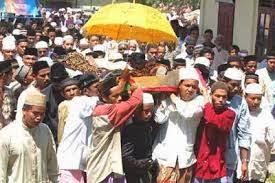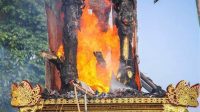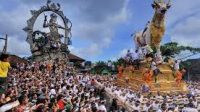KUPASONLINE.COM — Ammateang or the Death Ceremony, which in Bugis tradition is a ceremony carried out by the Bugis community when someone in a village dies. Families, close and distant relatives, as well as the people around the deceased person’s home environment flock to visit him.
Mourners who attend usually bring a sidekka (donation to the bereaved family) in the form of items such as sarongs or necessities to take care of the corpse, besides that there are also those who bring passolo (envelope containing money as a sign of condolences). The corpse has not started to be taken care of such as washing and so on before all its closest members are present.
It was only after all of his closest relatives were present that the corpses began to be washed, which was generally done by certain people who were used to washing corpses or by their own family members.
This was still in accordance with Islamic teachings in the procedure for taking care of the corpse in terms of washing it until praying it.
There are several things that need to be done when washing a corpse, namely mabbolo (to pour water on the corpse accompanied by reading prayers and tahlil), maggoso’ (rubbing the body parts of the corpse), mangojo (cleaning the anus and genitals of the corpse which is usually done by one of the a family member such as a child, younger sibling or by their parents) and mappajjenne’ (throwing the last bath water as well as making ablution of the corpse).
The people on duty were given pappasidekka (alms) in the form of the corpse’s clothing when it was alive complete with sarongs, clothes, pants, and so on. This is a unique thing where people who wash the corpse will receive a reward from the bereaved family in the form of the deceased’s belongings.
The corpse that has finished washing is then shrouded in a kaci cloth (shroud) by his closest family. After that the imam and some of his followers worship the corpse according to Islamic teachings. While outside the house, family members make ulereng (library) or coffin. In the Bugis tradition, in my village, coffins are only used once or they are no longer kept. This ulereng/keranda is for the tau samara group (most people) in the general population, while there is the term Walasuji (for the nobility) which is made up of 3 tiers. Walasuji or baruga with a rectangular rhombus motif is no stranger to the repertoire of Bugis civilization.
Walasuji/baruga
Aristocratic graves that use walasuji or baruga roofs
Simultaneously with the making of the ulereng/bottom casket, ceko-cekko is also made, which is a kind of covering in the form of a long arc along the grave which will be placed over the pile of graves when the body has been buried. And when all the Islamic procedures have been completed, starting from washing, shrouding, and worshiping the corpse, several people carry the body out of the house and then place it on a pestle.
Accompanying the corpse to the cemetery
The procedure for carrying the stretcher or ulureng is somewhat unique, which can be seen from the way it is still preserved by the Bugis community in the past.
Ulereng/veranda bottom is lifted up and then lowered again while stepping forward, this is repeated up to 3 times in a row, then proceed slowly to the cemetery followed by an escort group and mourners. The cortege of the cavalcade can take turns carrying the pestle. All people who pass by the escort must stop, while those walking/riding from behind may not overtake the escort until they reach the cemetery area.
At the cemetery, several people are waiting to work to help bury the body. Arriving at the grave, the corpse was immediately lowered into the grave. The priest or community figure then places a handful of soil on which prayers or incantations have been recited onto the corpse’s face as a sign of siame’ (unification) between the soil and the corpse.
After that, the corpse begins to be covered with earth until it is finished.
Then the Imam reads the talkin and tahlil with the intention that the corpse can answer the questions of the angel guarding the grave smoothly. Above the tomb is placed a coconut that has been halved and left on the grave. Also placed dancekko-cekko’ umbrella. This is also still a legacy of the old belief of the Bugis people, that even though someone has died, his spirit still roams around. Therefore, the coconut and its water which are placed on the grave are intended as a drink for the spirits of those who have died, while the umbrella is not only to protect the spirit, it is also a symbol of descent.
Currently, there is a new custom after the body is buried, namely the priest or ustadz is ordered by the deceased person’s family to continue with the funeral lecture before the entourage/mourners return from the grave. Lectures or religious messages that are generally conveyed in connection with death and preparation for death, that death will surely meet/face everyone in this world. Next, there is the delivery of invitations to takziah.
Overnight, at the funeral home, tahlilan and khatam Al-Quran are held, namely reading the Al-Quran alternately.
From here begins the Bilampenni, which is the ceremony of salvation as well as the counting of the days of death which are calculated starting from the day the corpse is buried. Usually, salvation is held for seven days or forty days. In closing the Bilampenni, namely, the next day, the dhikr of Barzanji is performed and continued with lunch with the invited relatives.
In Bugis custom, if someone dies a few days later, usually on the third, seventh, fortieth, hundredth day or whenever the deceased’s family can carry out a traditional ceremony called mattampung, in this traditional ceremony a cow is slaughtered.(*)







